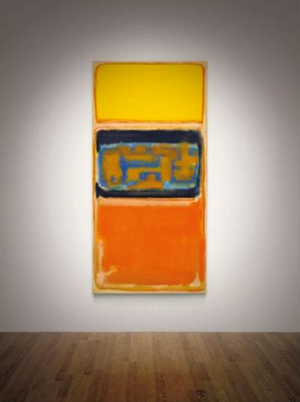
Two giants of Post-War American painting will be united in Christie’s Auction on 7 March 2017.
Two giants of Post-War American painting will be united in Christie’s Post-War and Contemporary Art Evening Auction on 7 March 2017 in London. Mark Rothko’s groundbreaking No. 1 (1949, estimate on request), is one of the artist’s earliest examples of his mature artistic vocabulary, dating from the pioneering year of his practice and was first shown in 1950 as part of his historic solo exhibition at New York’s Betty Parsons Gallery. Robert Rauschenberg’s Transom (1963, estimate on request) comes to auction alongside a major retrospective of his work at London’s Tate Modern, and demonstrates the radical new visual language that went on to lead a generation of American artists towards global domination. Together these two masters of 20th-Century painting will lead the field of American talent that will take centre stage during 20th Century at Christie’s, a series of sales that takes place from 28 February to 10 March 2017. Ahead of the auction the works will tour and be exhibited in Hong Kong (17-20 January), Shanghai (8 February), Beijing (11-13 February) and New York (24-26 February).
Having never been previously offered at auction, Rothko’s No. 1 is one of the few works from the 1950 Betty Parsons Gallery show that remain in private hands and heralds the incandescent union of light and colour for which his work would come to be much celebrated. Of the suite of 12 paintings, nine are now held in major American museums including: The Museum of Contemporary Art, Los Angeles (No. 2), The Museum of Modern Art, New York (No. 3), Los Angeles County Museum of Art (No. 4), Walker Art Center, Minneapolis (No. 6), National Gallery of Art, Washington (No. 7, No. 8), Hirshhorn Museum and Sculpture Garden, Washington (No. 9), and Frances Lehman Loeb Art Center, New York (No. 12). The importance of No. 1 to Rothko’s practice is underlined by the fact that he guarded the work and kept it in his possession until his untimely death. A glowing vision of rich orange and lemon-bright yellow, punctuated at its core by a dramatic zone of ochre strokes upon a bar of vaporous blue and teal, No.1 paved the way for the transformative painting as mood for which he is critically acclaimed.
Robert Rauschenberg honed the visual language of his series of Silkscreen Paintings between 1962 and 1964, which went on to earn him the Grand Prize for painting at the 1964 Venice Biennale. A central focus of the current Tate Modern retrospective is a room dedicated to the Silkscreen Paintings, reflecting their centrality to his oeuvre and the profound contemporary relevance for artists working today. Amongst the first artists to use silkscreens in his practice, Rauschenberg commenced this series around the same time his friend Andy Warhol also started to employ the process. Transom demonstrates Rauschenberg’s unmatched skill for the technique: against a white ground, repeated rooftop water towers are silkscreened in black and blue, framing the composition right and left as if each edge is a horizon. Transom sees images of war, urbanisation and consumer culture jostle for attention with a paragon of art history: Velázquez’s Rokeby Venus. The iconic nude appears three times in the work - in a blaze of red and yellow in the centre of the canvas; in a slice of blue stretched along the upper edge; and at the lower edge her free-floating face peers out from her mirror below a red truck wheel. This vivid tableaux demonstrates Rauschenberg’s talent at its height, marking the dramatic shift of focus towards America as the dominant force in contemporary culture.
Mark Rothko (1903-1970), No. 1 (Painted in 1949). Oil on canvas, 78.3 x 39.7 in. (198.8 x 100.8 cm.) Estimate on Request.
Robert Rauschenberg (1925-2008), Transom (Painted in 1963). Oil and silkscreen ink on canvas, 56 x 50 in. (142 x 127 cm.). Estimate on Request
More information is here.

ArtDependence Magazine is an international magazine covering all spheres of contemporary art, as well as modern and classical art.
ArtDependence features the latest art news, highlighting interviews with today’s most influential artists, galleries, curators, collectors, fair directors and individuals at the axis of the arts.
The magazine also covers series of articles and reviews on critical art events, new publications and other foremost happenings in the art world.
If you would like to submit events or editorial content to ArtDependence Magazine, please feel free to reach the magazine via the contact page.